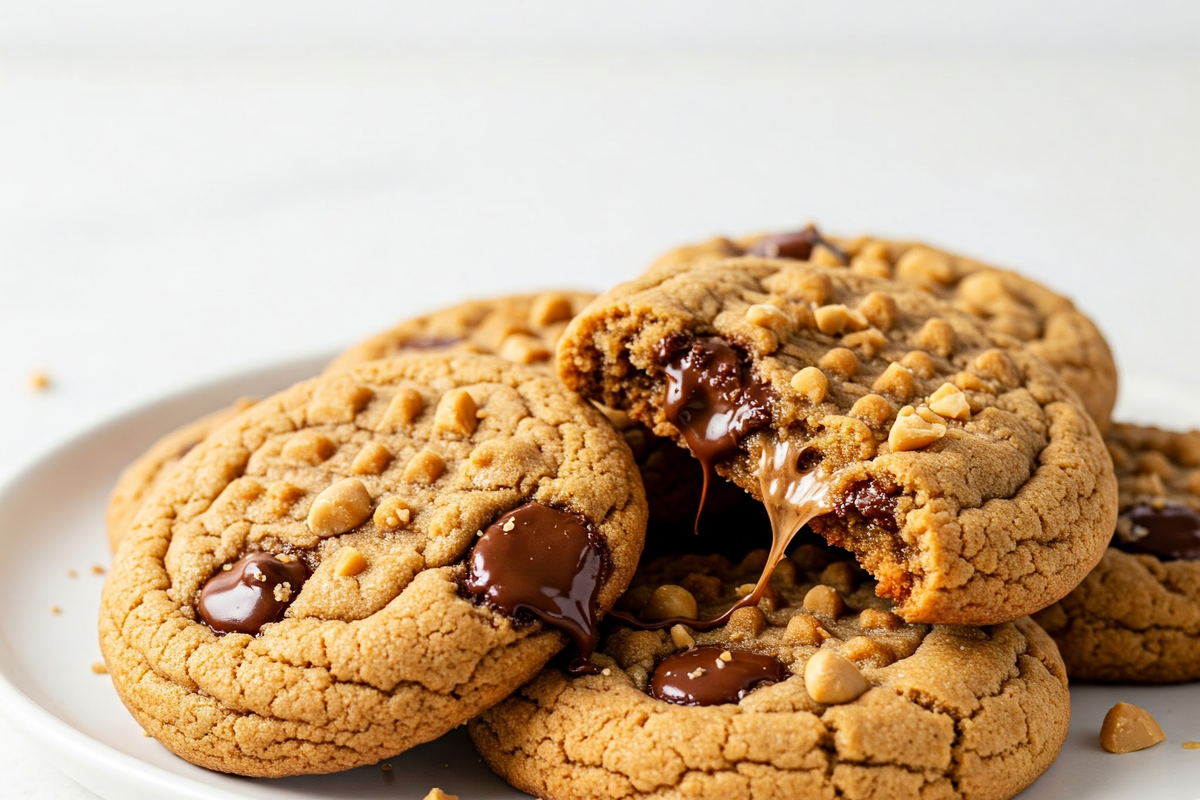Peanut butter cookies are a beloved treat, but have you ever wondered what is the purpose of peanut butter in cookies? It’s not just there to taste good (though it certainly does!). Peanut butter plays a crucial role in shaping a cookie’s texture, flavor, and even nutritional profile. This article dives into the history, science, and culinary artistry behind peanut butter cookies, offering you a full understanding of why this creamy spread is a cookie-baking favorite. Let’s start by exploring its foundational role in cookie-making.
Introduction to Peanut Butter in Cookies
What makes peanut butter a key ingredient in cookies?
Peanut butter isn’t just a flavor booster—it’s a game-changer in cookie recipes. Its high fat content provides a rich, moist texture, making cookies chewy rather than crumbly. Additionally, the proteins in peanut butter contribute to structural integrity. That’s why you get cookies that are soft on the inside but hold their shape.
Peanut butter also brings a slightly salty undertone, enhancing other sweet flavors like chocolate or caramel. As soon as peanut butter enters the mix, it helps balance sweetness, resulting in cookies that taste complex and satisfying.
A brief history of peanut butter cookies
The origins of peanut butter cookies date back to the early 1900s, with recipes inspired by George Washington Carver’s push to popularize peanuts as an affordable and nutritious crop. These cookies quickly became an American staple, especially during the Great Depression, thanks to their simple, budget-friendly ingredients.
The Role of Peanut Butter in Cookie Texture and Structure
How peanut butter affects cookie softness and chewiness
When baking cookies, texture is everything. Ever noticed how peanut butter cookies tend to be softer and denser than other cookies? That’s no accident. Peanut butter is rich in both fats and proteins, which help retain moisture in the dough. This moisture ensures that cookies bake with a tender, chewy interior. The high fat content also adds a richness that enhances the mouthfeel, making every bite more satisfying.
Additionally, peanut butter contains natural oils that slow down moisture loss. This process prevents the cookies from becoming stale too quickly. In short, peanut butter creates a cookie that not only tastes good but also stays fresh longer.
Creating the perfect balance: Crunchy vs. chewy cookies
The beauty of peanut butter in cookies is its versatility. You can tweak recipes to get either a soft or crunchy cookie, depending on the balance of fats and sugars. For a crunchier cookie, use less peanut butter and bake a little longer. For a chewier texture, opt for creamy peanut butter and reduce baking time slightly.
The dough’s consistency also plays a role. Stiffer dough tends to yield crisp cookies, while softer doughs, with higher fat content, give that signature chewy bite. This flexibility makes peanut butter a favorite among bakers.
Enhancing Flavor Profiles with Peanut Butter
The nutty and savory flavor peanut butter brings to cookies
Peanut butter doesn’t just change the texture of cookies—it transforms the flavor too. Its deep, roasted nutty profile complements sweet ingredients like chocolate, sugar, and vanilla, creating a perfectly balanced treat. That slight hint of saltiness found in peanut butter enhances the sweetness, amplifying the overall flavor harmony. This is one reason why recipes like chocolate-peanut butter chip cookies are so popular.
When you bite into a cookie with peanut butter, you’re greeted with layers of flavor: rich, savory nuttiness followed by a sweetness that isn’t overpowering. This contrast keeps each bite interesting and memorable.
Why peanut butter pairs well with sweet ingredients like chocolate
Chocolate and peanut butter are a match made in heaven. The creamy texture of peanut butter blends seamlessly with the smooth richness of chocolate, creating a dessert that feels indulgent but balanced. The slight bitterness in dark chocolate offsets the peanut butter’s sweetness, while milk chocolate enhances its creaminess.
This classic pairing has become so beloved that countless cookie recipes highlight both flavors. Whether in swirls, layers, or chocolate chips, combining these two ingredients creates an irresistible dessert experience.
Would you like me to add internal links from RoomyRecipes if any highly relevant ones are found next?
Nutritional Benefits of Peanut Butter in Cookies
Peanut butter’s protein and healthy fats
Peanut butter isn’t just a flavor powerhouse; it’s also packed with nutrients that elevate the nutritional profile of cookies. Peanut butter is rich in healthy fats, protein, and essential vitamins like Vitamin E and magnesium. These nutrients help provide energy and promote satiety, meaning you feel fuller for longer.
In comparison to regular sugar-heavy cookies, peanut butter cookies offer more protein, which can help stabilize blood sugar levels. The combination of fats and protein also creates a more balanced snack, perfect for active individuals needing a quick energy boost.
However, balance is key. While peanut butter adds nutrition, it’s also calorie-dense, so portion control matters if you’re watching your intake.
Comparing traditional cookies and peanut butter cookies in terms of nutrition
When you compare regular butter-based cookies to peanut butter cookies, you’ll notice a key difference: protein content. Peanut butter cookies tend to have double the protein and fewer refined fats. Substituting peanut butter for other fats can also reduce unhealthy saturated fat levels.
For more nutritious snack inspiration, check out this healthy snack recipe.
The Science Behind the Iconic Crisscross Pattern
How the crisscross pattern helps even baking
One of the first things you notice about peanut butter cookies is the distinctive crisscross pattern. But have you ever wondered why it’s there? The fork-pressed pattern isn’t just decorative—it serves a practical purpose. Peanut butter dough is denser than regular cookie dough due to its high-fat content. Flattening the dough ensures even heat distribution during baking, preventing the cookies from being undercooked in the center.
Theories and origins of the fork-pressed design
The crisscross pattern has been around for nearly a century, with early cookbooks suggesting it as a way to help bakers distinguish peanut butter cookies from others. Some theories say the tradition started because peanut butter dough tends to puff up too much without the flattening process. Regardless of its origins, the pattern has become a symbol of this beloved cookie.
Popular Variations of Peanut Butter Cookies
Classic peanut butter cookie recipes
For generations, peanut butter cookies have been made with just a few simple ingredients: peanut butter, sugar, and eggs. This minimalist approach yields a rich, chewy cookie that highlights the nutty flavor of the peanut butter. The classic recipe often features the iconic crisscross pattern and can be tweaked to personal taste—whether by adjusting sugar levels or baking time to get a softer or crispier texture.
Many home bakers also enjoy adding peanut chunks for a bit of crunch or a sprinkle of sea salt to enhance flavor. Despite these variations, the core of the recipe remains consistent, showcasing the purpose of peanut butter in cookies: to create a balance of texture and taste.
Creative twists: adding chocolate, nuts, or spices
For those who crave variety, peanut butter cookies can be customized endlessly. Adding chocolate chips, for instance, takes the classic recipe to a whole new level. You can also mix in nuts like almonds or pecans for extra crunch. Some recipes call for cinnamon or even chili powder to give the cookies a spicy kick!
Experimenting with these ingredients lets bakers create unique versions while preserving the cookie’s comforting core flavors.
Cultural and Historical Significance of Peanut Butter Cookies
Peanut butter cookies during the Great Depression
Peanut butter cookies rose to prominence during the Great Depression when simple, affordable ingredients were essential. Thanks to peanut butter’s long shelf life, high nutritional value, and low cost, it became a pantry staple. Families used it to make nourishing snacks like cookies, which offered comfort during hard times.
These cookies not only provided energy but also satisfied sweet cravings without expensive ingredients. During this period, recipes like the classic three-ingredient peanut butter cookie became household staples.
How peanut butter cookies became a comfort food in American culture
Today, peanut butter cookies hold a nostalgic place in American cuisine. For many, they evoke memories of baking at home with family or enjoying cookies fresh from the oven on a cold day. Their warm, rich taste and simple preparation make them a go-to comfort food.
Peanut butter cookies are also a common feature in celebrations, cookie swaps, and bake sales. Their deep-rooted cultural significance continues to bring joy, connecting generations through shared culinary traditions.
Peanut Butter Substitutes for Different Diets
Nut-free alternatives
For those with peanut allergies or dietary restrictions, you might wonder, What is the purpose of peanut butter in cookies if you can’t eat peanuts? Thankfully, there are several alternatives that mimic its creamy texture and rich taste. Sunflower seed butter is a popular nut-free option that delivers a similar flavor profile and consistency. This alternative also bakes well, keeping cookies moist and chewy.
Other options like soy butter or coconut butter can be used too. While these substitutes alter the flavor slightly, they still offer that essential balance of fats and proteins needed to produce soft, flavorful cookies.
Gluten-free and vegan peanut butter cookie adaptations
Peanut butter cookies can easily be made gluten-free and vegan with a few substitutions. For a gluten-free option, replace regular flour with almond or oat flour. If you’re going vegan, swap eggs with flaxseed or applesauce.
The high fat content in peanut butter or its alternatives helps maintain structure even without traditional ingredients. These adaptations ensure that everyone, regardless of dietary needs, can enjoy a warm batch of cookies with all the comforting flavors intact.
FAQs Section Based on “People Also Ask”
Can you make peanut butter cookies without peanut butter?
Yes! You can replace peanut butter with almond, cashew, or sunflower seed butter. These substitutes provide a similar texture and flavor, although each brings a slightly different taste. This is especially useful if you have allergies or prefer a different flavor profile.
What is the best way to store peanut butter cookies?
To keep your peanut butter cookies fresh, store them in an airtight container at room temperature for up to a week. You can also freeze them in a sealed bag or container for longer storage. Just let them thaw at room temperature before serving to maintain their texture.
Are there global variations of peanut butter cookies?
Absolutely! While peanut butter cookies are especially popular in the U.S., variations exist worldwide. In some regions, nut butters like sesame paste are used instead. In Europe, bakers might add hazelnuts or drizzle the cookies with chocolate for extra richness.
Would you like me to wrap up with Part 10 next?



